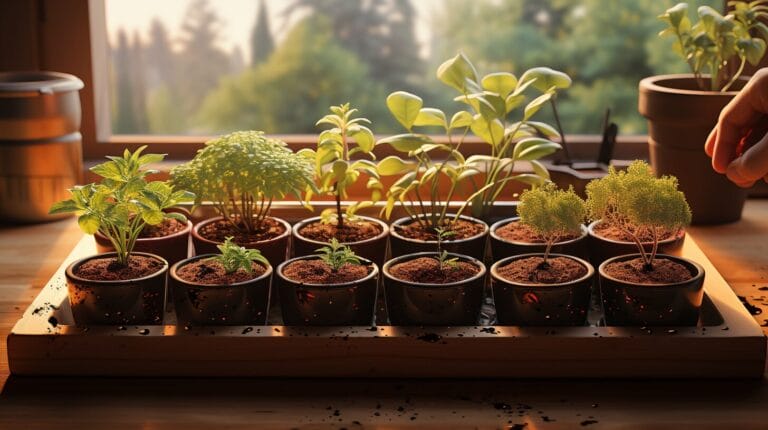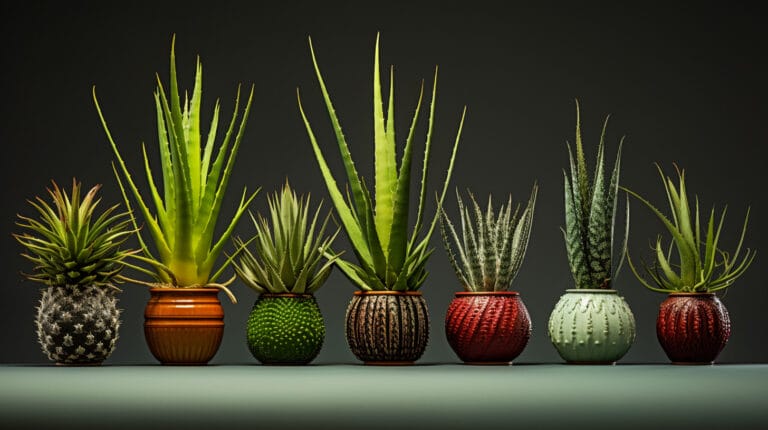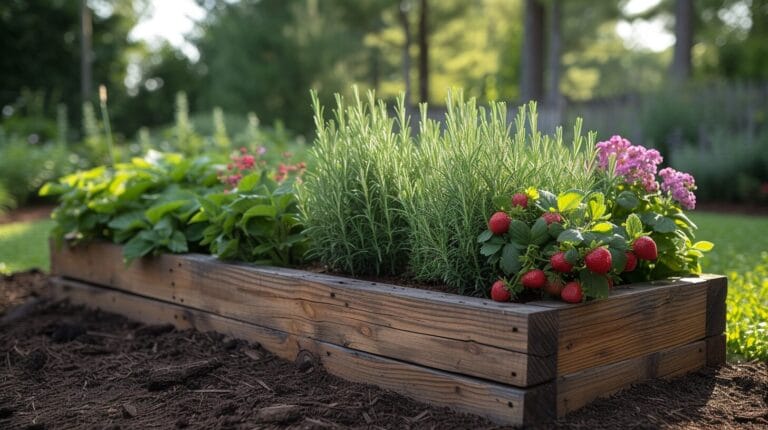In the dynamic world of indoor gardening, the appeal and vivacity of the Wandering Jew plant, also recognized as Tradescantia zebrina, truly stands out. The plant’s intriguing name and fast-growing nature have made it a favorite choice among gardening enthusiasts, from beginners to seasoned experts. My extensive experience in caring for these plants has consistently reinforced this sentiment.
Embarking on an exploration into the enchanting world of the Wandering Jew is like leafing through a living manual brimming with seasoned insights on care, creative ways to showcase its beauty, savvy propagation methods, and keeping it flourishing within your personal slice of nature’s tapestry.
The captivating foliage that it proudly unfurls is more than just eye candy; it’s a sturdy emblem of resilience and versatility that can thrive in both cozy corners indoors or as a vibrant accent under open skies.
Together, we’ll peel back the layers of this resilient botanical marvel—are you ready to let its story unfold?
Key Takeaways
- The Wandering Jew, also known as Tradescantia Zebrina, has striking silver, purple, and green leaves.
- It’s easy to care for, needs bright but indirect light, and can grow in soil or water.
- This plant grows fast and is perfect for filling garden spaces or as a decorative houseplant that cleans the air.
- Propagating the Wandering Jew is simple: cut a stem, remove lower leaves, then place it in water or soil until roots form.
- Besides looking pretty, this plant helps with soil erosion control and attracts beneficial insects like bees and butterflies.
What is a Wandering Jew Plant?
Drape your indoor spaces in vibrant hues with the botanical marvel Tradescantia Zebrina. This fascinating specimen, often called the “Wandering Jew” plant, boasts an eclectic mix of silver, purple, and green—a true cascade of colors ready to enliven any corner or windowsill it graces.
Watch this video to learn more.
Unraveling the Botanical Details: Understanding ‘Tradescantia Zebrina’
I love talking about plants, and the Tradescantia Zebrina is one I can’t get enough of! This plant has a unique name that some people know as Wandering Jew. It’s pretty special because it comes from warm places like North and South America.
The stripes make it stand out – it looks like silver paint was brushed across its leaves.
Caring for it isn’t too hard, either. It loves light but not too much sun all at once. When you pick a spot for it in your house or garden, make sure it gets a soft, bright light.
And guess what? Those shiny leaves aren’t just nice to look at; they grow in a cool pattern that trails down, which looks amazing in hanging pots or climbing up things! If any pests try to bother it or if the leaves start looking sick, with spots or white powder, there are ways to help keep the plant healthy and happy.
The Allure of the Wandering Jew: Unique Characteristics and Qualities
The Wandering Jew grabs your attention with its heart-shaped leaves, purple stripes, and a shimmering silver touch. Its speedy growth lets gardeners see changes quickly, making it fun to watch day by day.
You’ll find this plant hard to miss when the sunlight hits its leaves just right, lighting up the room or garden with a splash of color.
This lively plant brings life indoors as a houseplant, too. It’s not picky about where it lays its roots – in soil or water, it will grow! Flowers showing off three pretty petals in colors like violet, white, or pink add an extra sparkle wherever they’re placed.
Keeping this gem happy is easy with some bright light away from direct sun and comfy temperatures between 60 and 80 degrees Fahrenheit.
Cross-Components: Understanding the Wandering Jew Versus Similar Species
Indeed, the unique characteristics of Tradescantia zebrina captivate plant lovers. Yet, distinguishing it from its botanical counterparts presents an intriguing challenge. Here’s a snapshot comparison to explore the cross-components of these verdant wonders:
| Characteristic | Tradescantia Zebrina | Tradescantia Fluminensis ‘Quicksilver’ | Tradescantia Pallida ‘Purple Heart’ |
|---|---|---|---|
| Leaf Color | Purple and green stripes | Green with white variegation | Solid purple |
| Growth Habit | Trailing vines | Spreading, mat-forming | Upright or trailing |
| Light Requirements | Bright, indirect light | Bright, indirect light | Full sun to partial shade |
| Soil Preference | A moist, well-draining soil | A moist, well-draining soil | Well-draining, fertile soil |
| Native Region | North and South America | South America | Eastern Mexico |
| Invasiveness | Can be invasive outdoors | Considered invasive in some regions | Less invasive than other |
| Best Used As | Indoor plant, groundcover | Groundcover, garden plant | Accent plant, in borders or pots |
This table aims to untangle the similarities and distinctions between the various species of the Tradescantia genus, helping enthusiasts discern the nuances that make each plant special in its own right. Enjoy the visual and practical attributes these species bring to your green spaces, indoors or out.
Unpacking the Aesthetic Appeal of the Wandering Jew
The Wandering Jew, with its mesmerizing stripes and vibrant hues, carries a visual symphony of color that can instantly elevate any space. Let’s delve into the transformative power this botanical wonder holds in reshaping our perception of beauty within both lush garden beds and serene indoor sanctuaries.
Watch this video to learn more about its aesthetic appeal.
A Closer Look: Recognizing the Signature Stripes of the ‘Tradescantia Zebrina’
I love sharing about the Tradescantia Zebrina. This amazing plant has leaves that catch your eye right away. Picture soft, velvety greens mixed with deep purples, and then imagine them lined with shimmery silver stripes.
That’s what makes this plant stand out in any room or garden.
Each leaf is like a little work of art. They grow long and have points at the ends, which look really cool, dangling from a hanging basket or spilling over the side of a planter. And because these plants grow fast, you’ll see their lovely pattern spread quickly around your space!
The Wandering Jew’s Influence on Garden Aesthetics
Recognizing the signature stripes, we now explore how this plant shapes garden beauty. The Wandering Jew splashes gardens with deep purples and fresh greens, making every corner they grow in pop with color.
They trail gracefully over pots or spread as a lush carpet across the ground. This vibrant look turns simple spaces into stunning scenes.
These plants are not just easy on the eyes but also practical for filling in gaps where other plants may struggle to thrive. Their fast-growing nature means you get full and lively displays quickly.
With these beauties around, any outdoor setting becomes more inviting and dynamic because of its colorful foliage and versatile growth habits.
Enriching Indoor Spaces: The Wandering Jew as a Houseplant
The Wandering Jew makes a great houseplant because its pretty leaves bring life to indoor spaces. It loves to climb and spread, perfect for hanging baskets or high shelves.
This plant needs light that isn’t too strong and slightly sour soil. Putting one in your room can help clean the air, making your home feel fresh.
Taking care of this plant inside can be easy if you watch out for little bugs like spider mites and problems from watering too much. It grows well with bright spots around the house but not direct sun.
Those lovely stripes on its leaves look their best when everything is just right!
Cultivating a Healthy Wandering Jew Plant: Care Needs and Best Practices
Discovering the secrets to thriving Tradescantia Zebrina involves more than just admiration—it’s about understanding its unique care needs, which can turn even a novice into a plant-care pro. Keep reading for insights into crafting the perfect environment for your vibrant houseguest.
Watch this video to learn more about cultivating it.
Light, Water, Soil: Creating the Ideal Environment for Your Wandering Jew
I have a Wandering Jew, and I want to share how to make this plant happy in your home. It loves certain things to grow well. Let’s look at light, water, and soil needs.
- Light Needs: Your plant will do best in bright but not direct sunlight. Think of a spot near a window where the sun doesn’t hit it all day. Aim for about 8 hours of light each day. This keeps its leaves looking their best.
- Watering Right: Water when the top inch of soil feels dry. Don’t let the soil get too wet or too dry. Over-watering is bad news—it can cause root rot. Underwatering makes your plant sad and droopy.
- Perfect Soil: Grab some acidic potting soil with a pH between 5.0 and 6.0. Make sure it drains well—you don’t want water to sit around the roots.
- Spot Check: Place your plant in an area that fits well within hardiness zones 9-11 if you’re growing it outside.
- Room to Grow: Give each plant enough space when planting more than one together—about 10 to 14 inches apart should be good.
Navigating Potential Plant Health Issues: Pests, Diseases and More
After setting up the perfect spot for your Wandering Jew, it’s time to tackle another key aspect of their care: keeping them safe from pests and diseases. This can be tricky, but I’ve got some tips to help you out.
- Regular Inspection: Frequently examine for signs of distress. Look for discoloration, wilting, or unusual spots on leaves which might indicate an issue.
- Pest Identification: Be on the lookout for common pests such as aphids, spider mites, and mealybugs. These tiny critters can cause significant damage if not controlled.
- Natural Remedies: Use natural pest control methods like neem oil or a soap water solution to safely eliminate pests without harming your plant.
- Quarantine New Plants: When introducing new plants into your space, keep them separate from your plant initially. This helps prevent the spread of any unseen pests or diseases.
- Proper Watering Techniques: Overwatering can lead to root rot and other fungal diseases. Ensure soil is well-draining and only water when the top inch of soil is dry.
- Adequate Air Circulation: Ensure good air circulation around your plant. Stagnant air can promote the growth of mold and mildew.
- Pruning and Maintenance: Regularly prune dead or dying leaves and stems. This not only keeps your plant looking tidy but also helps prevent the spread of disease.
- Fungus and Mold Awareness: Be vigilant about signs of fungus or mold, particularly in humid conditions. These can rapidly deteriorate the health of your plant.
- Using Pesticides Wisely: If you must use chemical pesticides, choose ones that are safe for indoor plants and apply them according to the instructions.
- Monitoring Soil Health: Occasionally check the pH and nutrient levels of your soil. An imbalance can make your plant more susceptible to diseases.
- Educating Yourself: Stay informed about common diseases that affect these plants, such as root rot and leaf spot disease, so you can act swiftly if they appear.
- Creating a Healthy Environment: Ensure it receives adequate light and isn’t subject to extreme temperature changes, as stress can weaken its defenses.
Seasonal Care Considerations: Keeping Your Wandering Jew Healthy Year-Round
Taking care of a Wandering Jew means paying attention to the changing seasons. Your plant will need different things as the weather changes.
- Spring and summer are the growing seasons for this plant. Give it lots of bright, indirect light. It will grow best with this kind of light. Water it when the top inch of soil feels dry.
- Keep an eye out for too much sun in the hot months. Leaves can get burned by too much direct sunshine. Move your plant to a spot with less light if you see signs like fading or spots on the leaves.
- Fertilize your plant every two weeks during these warmer months. Use water-soluble fertilizer to give it nutrients that help it grow big and strong.
- As fall comes, start to cut back on watering and stop feeding with fertilizer. The days get shorter, and it won’t grow as much.
- Prune any long or leggy stems in early fall to keep your plant bushy and full.
- Water even less in winter when your plant rests. The top layer of soil should be quite dry before you water again.
- Watch out for dry air inside during winter because heaters can make homes dry. It likes humidity, so mist it sometimes or use a humidifier nearby.
- Look for pests like spider mites and aphids all year, especially in winter when indoor plants can get more bugs.
- If cold drafts come from windows or doors, move them away from those areas in winter to avoid harm from cold air.
- Lastly, always check the soil moisture level no matter the season— keeping the soil just right is key!
How to Naturally Propagate a Wandering Jew
Propagating the Wandering Jew is a delightfully simple process, opening up a world of lush greenery right from your own home. With its notable resilience and ease of growth, you’ll find that expanding your collection or sharing with friends can be as simple as snipping and planting.
Understanding the Wandering Jew’s Propagation Style
The Wandering Jew has a special way of making more plants. You can cut off a piece of the stem and put it in water or soil to grow roots. This is called propagation, and it’s easy with this plant because the stems have places called nodes.
When you put these cuttings in the right spot, they grow new roots.
To get started, just pick a healthy part of your plant with a few leaves. Snip off about four inches from the tip and remove any leaves near the bottom. Now, you can stick this cutting into some water or damp soil.
Keep an eye on it, give it some light but not too bright, and soon you’ll see little roots reaching out. That’s when you know your Wandering Jew is starting its journey as a plant!
Hands-On: Step-By-Step Guide to Propagating Your Plant at Home
Growing your own Wandering Jew at home is simple and rewarding. You just need a few healthy stems from an existing plant to get started.
- Choose a Healthy Stem: Look for long, vibrant stems with several leaves. Make sure the stem has no signs of pests or diseases.
- Cut Properly: Snip the stem just below a leaf node using clean scissors or pruning shears. Nodes are the spots where leaves are attached, and new roots will grow from these points. Your cutting should be about 4-6 inches long.
- Remove Lower Leaves: Gently remove the leaves near the bottom of the cutting. You’ll put the stem in soil or water to root in this space without leaves.
- Rooting Medium: Decide if you want to root your cutting in water or soil.
- Place the Cutting in Water: Fill a small jar with water and submerge the bare part of the stem.
- Change Water Regularly: Keep an eye on your water level and change it every few days to keep it clean.
- Wait for Roots: In about a week or two, you should see tiny roots forming.
- Prepare Your Potting Mix: Use a mix that’s well-draining and slightly acidic, with a pH of 5.0 to 6.0.
- Plant Your Cutting: Stick the bare part of your stem into moist potting soil.
- Keep Soil Moist: Water enough to keep the soil damp but not soggy, as too much moisture can cause rotting.
- Provide Light and Warmth: Place your cuttings somewhere they can get plenty of bright, indirect light but no direct sun that could scorch them.
- Watch for Growth: After rooting occurs, usually within two or three weeks, you’ll notice new growth starting from the top of the cutting.
- Transplant if Necessary: If you started with water propagation, once roots are an inch or so long, it’s time to move your plant into the soil using similar potting mix conditions described above.
- Care for Your New Plant: Treat it like a mature Wandering Jew now! Give it light, regular watering (ensure good drainage), and some humidity for best results.
Troubleshooting Propagation Issues: Common Mistakes and How to Avoid Them
You’ve just learned how to propagate your Wandering Jew plant. Now, let’s make sure that those new cuttings grow strong and healthy.
- Incorrect Watering Practices:
- Overwatering can cause root rot in new growths.
- Underwatering leads to drying out, hindering rooting.
- Solution: Keep the soil consistently moist but not waterlogged.
- Inadequate Light Conditions:
- Excessive direct sunlight may scorch new propagations.
- Lack of light results in weak growth and poor rooting.
- Solution: Place new growths in bright, indirect light.
- Using Old or Diseased Mother Plants:
- Propagations from unhealthy plants often struggle to root and grow.
- Solution: Select healthy, vigorous plants.
- Improper Propagation Technique:
- Incorrectly taken propagules or using a dull blade can damage them.
- Solution: Use a sharp, clean tool and make precise cuts near nodes.
- Ignoring Humidity Requirements:
- Low humidity can cause new propagules to lose moisture quickly.
- Solution: Cover them with a plastic bag or use a humidity dome.
- Failing to Use Rooting Hormone:
- Rooting hormones can enhance the success of new growths.
- Solution: Apply rooting hormone powder to the base before planting.
- Neglecting Aftercare:
- Proper care is essential once new growths have been rooted.
- Solution: Gradually acclimatize them to their new environment.
- Poor Soil Quality:
- Dense or nutrient-poor soil hinders root development.
- Solution: Use a well-draining, nutrient-rich potting mix.
- Contamination and Disease Spread:
- Dirty pots or tools can introduce diseases.
- Solution: Sterilize tools and use clean pots for planting.
- Overcrowding New Growth:
- Planting too many propagations in one pot can lead to competition.
- Solution: Allow adequate space for each new plant to grow.
Can I Grow a Wandering Jew Plant from Grocery Store Garlic?
Growing garlic from grocery store cloves is indeed possible. However, the same cannot be said for growing a wandering Jew plant from grocery store garlic. While garlic can be re-grown, wandering Jew plants require cuttings or divisions to propagate. For successful results, try following growing garlic grocery store tips instead.
Fostering Symbiotic Relationships: The Wandering Jew and Its Ecosystem
Cultivating the Tradescantia Zebrina isn’t just about adding a splash of color to our homes or gardens; it’s also an invitation to enhance the very ecosystem we depend on. This robust plant does more than please the eye—it actively contributes to ecological balance, making it as beneficial as beautiful.
Let me show you how this remarkable species collaborates with nature, providing tangible benefits that underscore its place in a healthy, thriving environment.
Attracting Beneficial Insects: The Wandering Jew as a Pollinator Plant
The wandering jew plant is more than just a pretty face in the garden or pot. It’s a friend to bugs that help plants grow. The bright flowers can draw in good insects like bees and butterflies looking for food.
While they eat, they carry pollen from one flower to another. This helps plants make seeds and new plants.
Having it around helps keep the balance right for these helpful insects. They find what they need to live, and I get stronger, more colorful plants all around my garden or home.
Plus, watching the little creatures buzz and flutter about their day is fun!
The Role of the Wandering Jew in Preventing Soil Erosion
The Wandering Jew has a superpower for the ground. It grows fast and spreads over the soil like a green blanket. This helps keep the soil from washing away when it rains. The little roots grab on tight to dirt, holding everything together.
If you have hills or slopes in your garden, planting this friendly creeper can help stop the dirt from sliding down.
Let’s say you want to protect the earth with your home. You can use it as a living shield! Its thick leaves and sprawling stems cover up bare spots, so wind and water don’t blow or wash soil away.
This way of guarding against erosion is easy on your wallet, too, because these plants grow quickly from just small cuttings you can share with neighbors!
Co-Habitation: Plants That Thrive Alongside the Wandering Jew
Plants love company, just like people do. They can grow better together when they support each other’s needs. Here are some plants that get along well with the Wandering Jew and why they make such good partners:
- Spider Plants: These are great buddies for the Wandering Jew. Together, they create a lush, green vibe. Spider plants help clean the air, which is good for all the plants around them.
- Pothos: This plant likes the same kind of light as the Wandering Jew and doesn’t mind if things get a bit crowded. Their trailing vines mix nicely with their colorful leaves.
- Philodendron: Much like pothos, philodendrons enjoy similar conditions to those preferred by the Wandering Jew. They’re able to share space without fighting over resources.
Can I Learn More About Wandering Jew Plants from Your Guide?
Yes, you can learn everything you need to know about caring for Wandering Jew plants from our complete guide to wandering jew plant. Whether you’re a beginner or experienced gardener, our guide provides helpful tips on watering, light requirements, and propagation to keep your plants healthy and thriving.
Conclusion
The Wandering Jew plant, with its vibrant purple and green leaves, is a delight for any space. It’s easy to grow and perfect for beginners who want some green. You can make new plants from stem cuttings in no time at all.
They help keep soil strong and bring in good bugs, too. Let this lovely plant brighten up your home or garden today!
FAQs
What is a Wandering Jew Plant?
A Wandering Jew, also called Tradescantia Zebrina, is an evergreen perennial that grows quickly with dark green leaves and silver stripes. It’s easy to grow as a houseplant.
Why do some people say “Wandering Dude” instead?
Some people use the name “Wandering Dude” to avoid using the common name “Wandering Jew,” which can be seen as offensive because of its reference to an old story about a man cursed to walk the earth until Jesus comes back.
How do I care for my Wandering Jew plant?
To take good care of your Wandering Jew, give it lots of light but not direct sun, keep the soil moist, and ensure there’s high humidity around it. Pinch off long stems to stop it from getting leggy.
Is it true that the Wandering Jew plant can be invasive?
Yes, outside in warm climates, this plant can be invasive because it spreads easily and covers the ground quickly when grown outdoors.
Can I grow new plants from my existing ones?
Absolutely! You can grow more plants by rooting cuttings from healthy stems—just place them in water or soil, and they should root at the nodes on the stem.
When should I repot my Tradescantia Zebrina?
Repot your Tradescantia Zebrina every two or three seasons if you see it is becoming crowded in its pot or if you want to refresh its soil with organic compost and slow-release fertilizer for better health.







